High level of Brazilian men´s volleyball: characterization and difference of predictive factors of back row attack
DOI:
https://doi.org/10.6063/motricidade.12221Resumo
This study aimed to identify the predictive factors of attacks, performed from positions 1 and 6 according to the effect of reception in high level Brazilian male volleyball and to find the predictive factors that differentiate the game practiced from these positions. The sample consisted in the observation of 142 games of the Brazilian Men's Super League, totalling 2969 actions of reception, setting and attack from positions 1 and 6. The significance value adopted was 5% (p ≤ 0.05). The analysis of the predictive factors of the game performed by the attacker of position 1 showed greater chances to score after an excellent (odds ratio adjusted – ORA = 1.48) and moderate effect of reception (ORA = 1.31), the second attack tempo (ORA = 1.32), the powerful attack in parallel (ORA = 1.91) and in diagonal (ORA =3.44). The attacker of position 6 showed higher chances of scoring after a high effect of reception (ORA = 3.39) and powerful attack in the parallel (ORA = 1.53). In conclusion, regardless the effect of reception, the use of the back-row attackers is recommended to increase the uncertainty on the opposing team and the chances to score.
Downloads
Publicado
Edição
Secção
Licença
Os autores dos manuscritos submetidos para publicação deverão ceder, a título integral e permanente, os direitos de autor (copyright) à revista Motricidade e às Edições Sílabas Didáticas. A cedência de direitos de autor permite a publicação e divulgação do artigo em formato impresso ou eletrónico e entrará em vigor a partir da data de aceitação do manuscrito. Os autores concedem, ainda, os direitos para a revista Motricidade utilizar e explorar o respetivo artigo, nomeadamente para licenciar, ceder ou vender o seu conteúdo a bases de resumos/indexação ou outras entidades.
Nos termos da licença “Creative Commons”, os autores poderão reproduzir um número razoável de exemplares para uso pessoal ou profissional, mas sem fins comerciais. Nos termos da licença SHERPA/RoMEO, os autores poderão, ainda, disponibilizar/arquivar uma cópia digital final (versão postprint) do artigo no seu website ou no repositório científico da sua instituição.


